
Walton Burrell Senior April 1912
Quick links on this page
WRB's childhood from 1863
WRB learns photography 1881
Turns professional 1896
Modern postcard sales 1905
War time army camps 1914
Zeppelins, soldiers 1915
More Zeppelins, soldiers 1916
Ampton Hall casualties 1917
More casualties, camps, hospitals 1918
Move to Ampton 1919
BFP 'interview' WRB 1932
WRB dies at age 81 1944
Album saved by FOSRC 2000
Foot of Page
|
Walton Robert Burrell - Photographer
of Hall Farm, Fornham St Martin
(1863-1944)
| 1837 |
In 1837 Walton Burrell senior, father of our photographer, was born at Westley Hall, the home and farm of his father also called Walton Burrell, (1795-1879). The Burrells would become long standing farmers in Westley, a matter commemorated by the modern street name of Burrell's Orchard, still to be seen in Westley village.
Grandfather Walton Burrell was born at Great Wilbraham in 1795. He married Marian Cottingham at Cavenham on 4th October, 1832. He must have moved to Westley soon after as all their children were born there between 1834 and 1849. His mother was born Martha Brooks in about 1777 at Westley, and so perhaps this is how the Burrells came to that village.
|
|
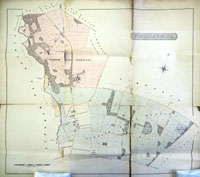
Fornham park estate sales map 1843
|
| 1859 |
In 1859 Walton Burrell senior moved to New Hall Farm, Fornham St Martin, to continue a farming career on his own account. He took over from the previous tenant, who was a cousin of the family. His father, also named Walton Burrell, remained farming at Westley Hall until his death in 1879.
New Hall Farm was part of the Fornham Park estate, which since 1843 was owned by Lord John Thomas Manners, Baron Manners. New Hall farm is visible on this Fornham Park estate sales map of 1843. The pale blue shading denotes land within the parish of Fornham St Martin.
|
| 1862 |
In 1862, Walton Burrell senior married Ellen Cowan, who took over the running of the household at New Hall Farm, and quickly began to start a family.
Lord Manners had owned the Fornham Park estate, including New Hall Farm, for less than 20 years. The entire Fornham Park estate and its property was sold by Lord Manners to Sir William Gilstrap in 1862. Gilstrap held it until his death in 1896. Gilstrap was a Nottinghamshire brewer, who paid £85,000 for it.
|
|

New Hall Farm |
| 1863 |
Our photographer, Walton Robert Burrell, was born at New Hall Farm on 16th February, 1863. Unfortunately he was deaf from birth. Later the farm would just be known as Hall Farm, as memories of the previous old farmhouse faded away.
|
|
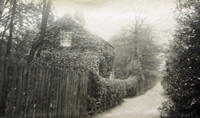
Keepers Cottage Southgate |
| 1867 |
In 1867 Walton Burrell was sent to a school for the deaf in Southgate, a small village in Edmonton in London. He has labelled this picture as "Keepers Cottage in wood towards Winchmore Hill from Southgate. It was where I walked almost daily when at school at Southgate from 1867 to 1872."
Southgate was recorded in the 1871 census as a village or hamlet in the civil parish of Edmonton. The address seems to be Fairview Lodge.
|
|
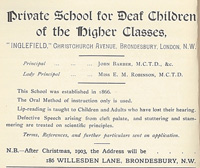
Deaf School advert from c1902 |
| 1871 |
By the time of the 1871 census Walton Robert Burrell was a live in pupil (age 8), at the progressive deaf school of John Barber, who had founded his private Deaf School in Edmonton, London, in 1866. A former pupil has described Barber as “a man of sincere religious fervour whom we all respected”.
Barber advertised his establishment as 'a private school for children of the higher classes', and 'the oral method of instruction alone is used'. No sign language was taught but lip reading was taught.
The school seems to have moved in 1872 and Walton Burrell moved with it.
In later years Burrell described how he communicated by written notes, so the oral method does not seem to have been effective for Burrell.
|
|
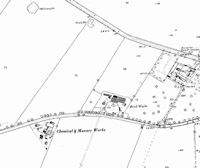
Chemical manure works Westley |
| 1875 |
Walton’s father and his Uncle Robert Burrell, (of Honey Hill) had set up a factory to make sulphuric acid and chemical fertilisers by 1875. This fact is recorded in the 1875 Suffolk Post Office Directory.
In the 1881 census there is an obscure note by the enumerator which appears to report that from December, 1879, Walton Burrell senior was not only a farmer employing 34 men, 3 women and 18 boys, but was also an employer of 8 men and 2 boys at the chemical manure factory. This note is somewhat unclear, but I think the sense is reasonably taken.
At this time the factory was in the parish of Westley, being just outside the pre-1934 borough boundary. Today the site would have the address of Westley Road, Bury St Edmunds. Please click on the thumbnail to see a wider view of the locality.
|
| 1879 |
In 1879, Walton Robert Burrell's grandfather, also named Walton Burrell, died at Westley Hall.
|
|
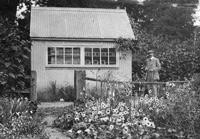
Burrell's darkroom shed |
| 1881 |
Walton was not the only Burrell child to be born deaf. Walton, (1863) William, (1866),Beatrice (1871) and Maud, (1877) were all deaf from birth.
By 1881 Walton had received 13 brothers and sisters, but two had died along the way.
The 1881 census shows William Burrell age 15 at the school and Beatrice Burrell age 10, with 13 other pupils. Maud was presumably too young at 4 years old to be sent away to boarding school.
Walton Burrell himself was back at Fornham, aged about 18, having spent 12 years at deaf school. He went to John Palmer Clarke at 7 Angel Hill to take a course in photography, a decision which would eventually change his life. He soon needed a workshop and darkroom for his new hobby, which was built in the garden at Hall Farm.
At this time he had a wide variety of interests. He collected stamps from age 10, butterflies and moths since 1877, and autographs. He had, for a time collected birds eggs but found that his deafness put him at a disadvantage for locating singing birds. However, he retained an interest in natural history throughout his life.
|
| 1882 |
One of his first pictures was of a meeting of cyclists on Angel Hill in 1882, with their penny farthing bicycles. This was described in a newspaper article in 1932, when the reporter, "The Penman", saw it. Burrell described his difficulties with the penny farthing and his later adoption of a tricycle as his main means of transportation.
Unfortunately, this picture is unknown today.
| 1890 |
A register of members of the British Deaf Association dated 1890 shows that Walton Burrell was member number 11 and his brother William Connaught Burrell was member number 12.
|
| |
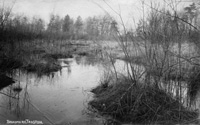
Broadmere - club shot |
| 1896 |
From 1881 to 1896 Walton Burrell was essentially an amateur photographer, entering competitions at the local photographic club, taking family pictures, occasionally getting a photo in the local press etc..
During this time he had made a living by buying and selling postage stamps by mail order. He was still living at home with his parents and no doubt his expenses were fairly low.
In 1896 he decided that he could make more money and find more satisfaction from taking up photography as his profession. From now onwards he always described himself as a photographer.
|
|
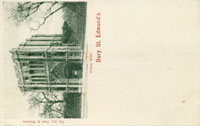
Postcard format 1894-1902 |
|
blank |
Plain postcards, with a pre-printed stamp, were introduced by the Post Office in 1870. The address was on one side, and a brief message was allowed on the other. From 1 September 1894, the Post Office allowed postcards published by others to be posted. A halfpenny adhesive stamp was to be added to these cards before posting.
Several manufacturers produced cards. The first publisher to include pictures on the cards is believed to have been George Stewart of 92 George Street, Edinburgh.
These early cards had the address on one side, and the message and the picture were on the other side. The format which we know today did not arrive until 1902.
This postcard of the Abbey Gate in Bury, published by Paul and Mathew, illustrates how the picture and the sender's message had to share one side of the card before 1902. The other side was strictly reserved for the words "Post Card" and the address and the stamp only.
Local firms like Paul and Matthew issued many postcards in this format, although the actual photographers used remain obscure. Not until 1902 were these regulations amended to allow a picture to occupy the whole of one side of a postcard.
|
|
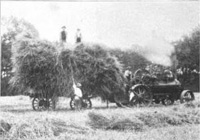
Picture in the Sketch |
| 1898 |
In the Sketch newspaper of September 14th 1898, Burrell had one of his pictures published to illustrate an article written on the vagaries of the motor car and modern transport methods. The picture is labelled "How they cart corn by steam in Suffolk. Picture by Walton Burrell Bury St Edmunds." The writer continues, "The traction engine among the sheaves is less picturesque than the horse, but it does a good many horses' work."
You can click on the thumbnail to see the article.
| 1899 |
From 1899 to 1902 it is believed that Walton was living at his brother William's farm at Cattishall hamlet, Great Barton. The Record Office have a picture of his room there entitled "My sanctum at Barton."
|
| |
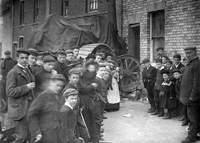
Eastgate Street crash |
| 1900 |
Suffolk Record Office have this picture dated to 1900, and labelled "Runaway engine at Eastgate, Bury St Edmunds, Suffolk K997/115/3 1900 'Going into a cottage'". This was one of Burrell's pictures that SRO digitised in 2004 and 2005 and subsequently published on the internet.
|
|
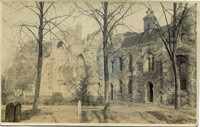
Abbey ruins by WRB |
| 1905 |
After the 1902 postcard reforms the earliest Walton Burrell postcard that is both dated and unequivocally attributable to him is this view of the West Front of the Abbey ruins in Bury St Edmunds. The reverse also shows that Burrell was actively selling these cards in a commercial manner. He is writing to the Reverend Lord Charles E Fitzroy, at Euston Rectory, on Boxing Day, 1905, thanking him for his postal order, and promising to send him a dozen views shortly.
|
|
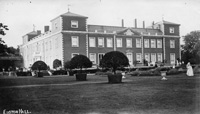
Euston Hall postcard
|
|
blank |
Many postcards exist of views around the Euston Estate, but at this time Burrell appears not to have signed his work or left any other identifying indications on the cards.
|
|
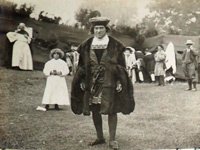
Robert Burrell as Sir Thomas Kytson |
| 1907 |
Along with many other photographers Walton Burrell took pictures of the Bury St Edmunds Pageant of 1907. He photographed several of the cast in their pageant costumes, including his Uncle Robert, shown here.
|
|

Walton and Frank Burrell on ice
|
| 1908 |
The weather in 1908 provided Burrell with several photo opportunities, beginning with scenes on frozen fields on the farm. The first picture is from January 1908, showing Walton and his brother Frank Burrell on skates. The Farm’s carpenter is brought along to show his medals.
|
|
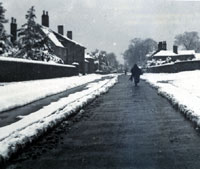
Snow on April 24th |
|
blank |
On April 23rd - 24th 1908 a freak late snowstorm provided several snow scenes to be made into cards for sale. There was a heavy fall of snow on Easter Monday, April 20th, and the weather remained unseasonably cold. Snow in April is not unusual, but in late April it is most uncommon. This postcard shows the unusual feature of snow and slush on April 24th 1908. The picture was taken at Fornham St Martin, and printed as a postcard. There is no publisher's name on the postcard, but it was certainly produced by Walton Burrell, who lived at Hall Farm in Fornham. Next day, on April 25th, a blizzard raged across southern England.
|
|
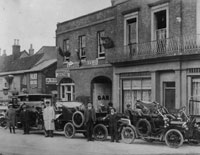
Frank Burrell's garage |
|
1910
|
Before the Great War Burrell was competing with several Bury St Edmunds based photographic studios, including Farringdon, Harry Jarman, Drews Imperial Studios, and the national postcard producers like Valentines, Mitchell and Lang etc.. Burrell had to concentrate upon local villages and events that other producers overlooked as too small to be worth the effort.
One opportunity was to produce advertising cards for his brother, Frank Burrell, who had opened a motor garage in Mustow Street, just round the corner from the Angel Hill.
|
|
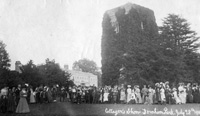
Cottagers Show July 28th 1910 |
|
blank |
This card is a typical Burrell from this period, entitled "Cottagers Show Fornham Park, July 28th 1910."
|
|
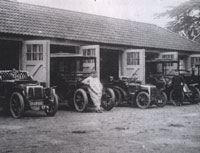
Cars at Ampton Hall |
| 1911 |
Ampton Hall had converted most of its stables into garages for the motor car. The gentry who owned these vehicles usually employed a chauffeur to drive them around. Burrell took this picture of local vehicles at Ampton Hall in 1911. The registration letters "CF" indicate that each vehicle was registered with the West Suffolk County Council, at the Shire Hall in Bury St Edmunds. He also photographed the drivers and sold individual cards to them, as well as views for their owners.
|
|
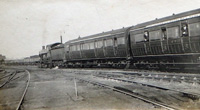
Harwich to York 1911 |
|
blank |
This picture shows the Harwich to York train passing Bury in 1911. Some passengers are looking out of the windows. In his album Burrell writes, "Perhaps Huns looking outside the windows"; a note which must have been written during or after the Great War.
|
|
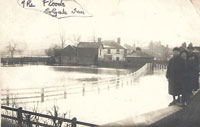
Floods at Tollgate area
|
| 1912 |
The year 1912 saw the wettest recorded summer ever in the United Kingdom. During August there were heavy rains and widespread flooding in Suffolk. On the 24th August, about four inches of rain fell in 16 hours. The postcard here is by W R Burrell and was kindly supplied by Ronnie Munday from her Grandmother's photo album. It shows the Tollgate Bridge area flooded with the Tollgate inn in the background. The reverse has a note saying, "The Tolgate Inn Mr George Todd Landlord." It also contains Walton Burrell's rubber stamp, as photographer. This is the earliest recorded use of his rubber stamp that I have found so far (by 2020). Unfortunately there is no negative number still visible.
From September 16th to the 19th, 1912, the army held its last large scale manoeuvres before the Great War broke out in 1914. The scenario, as described on Wikipedia, was that a Redland Army under Lieutenant-General Sir Douglas Haig, had invaded from a line along the North Norfolk coast, heading for London. The Blueland army, made up of Southern Command (3rd Division) and Eastern Command (4th Division and Territorials), were based around Cambridge, and had to stop the Redlanders from reaching London. The 2nd Battalion of the Suffolks was part of the Blueland defending army. Burrell undoubtedly took some pictures during these events.
|
|
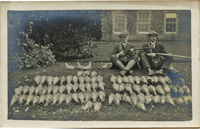
Pigeon Shoot |
| 1913 |
This postcard includes Burrell's rubber stamp on the reverse with a negative number of 755. This might date it to around 1913, but his numbering system, when he used it, often seems a bit erratic. Undoubtedly these two are members of the Burrell family, seen on the front lawn of New Hall Farm, but I cannot positively name them at present. (Possibly his father, Walton Burrell, and his brother Frank.)
|
|

Barton Hall fire |
|
1914
|
In January 1914, fire broke out at Great Barton Hall, totally destroying it as a residence. Burrell attended the scene on January 10th and took several pictures. At this time he was relying on identifying his pictures by a description scratched into the negative relating the scene portrayed. Such a description had to be etched using 'mirror writing' so that the viewer could read it normally when the positive image was printed.
|
|

Suffolk Yeomanry at Culford |
|
blank |
At some point he began to number his negatives by a four digit number similarly scratched into the emulsion of the negative.
For example this postcard of the 3/1 Suffolk Yeomanry at Culford is dated 24th July, 1914, and the negative number is 1436.
One issue was that if he enlarged or cropped the subsequent picture the number might not appear on the resulting postcard. Or the number might appear truncated if next to the edge of the picture.
|
|

Example Burrell rubber stamp |
|
blank |
Since at least 1912 he had used a rubber stamp on the reverse enscribed "Photo W R Burrell Fornham St Martin, Suffolk. Negative No......" where the number could be added in pencil or pen. Unfortunately the stamp is not present in all cases, and in a few cases where the stamp has been applied, the negative number has been omitted. This probably reflected the pressure of work he was under during his frequent hospital and camp visits. The example shown is numbered 1319, and is on a card of boxers facing off, and must date to summer, 1914.
|
|
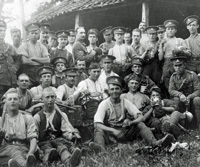
Burrell's first soldiers
|
|
blank |
August Bank Holiday Fete, 1914, at Hardwick Heath on the edge of Bury St Edmunds, was a day of merrymaking. The next day, the country was at war.
Britain entered the First World War on 4th August 1914, and the regulars and territorials were mobilised. Army reservists streamed into Bury from all over Suffolk and far beyond.
This picture, labelled "R.F.A. (Northamptonshire), Livermere, Suffolk", by Suffolk Record Office, was, according to Burrell himself, the first of Walton Burrell's extensive series of pictures of soldiers during WWI. It is dated August, 1914, and so must have been taken within 3 weeks of war being declared. RFA stands for Royal Field Artillery. "The very first evening I took soldiers August 1914 R.F.A. (Northamptonshire), Livermere".
|
|
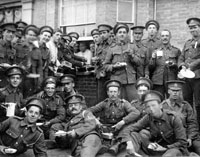
Royal Engineers at the Woolpack
|
|
blank |
Large temporary encampments were set up around the country to house and train the thousands of mobilised men. In October a contingent of Royal Engineers set up a tented encampment at Fornham St Martin. This occupation extended along the fields behind and around the church and the Woolpack inn. This postcard, one of many such pictures taken by Walton Burrell, shows the Royal Engineers gathering outside the Woolpack as they arrive to set up camp.
|
|
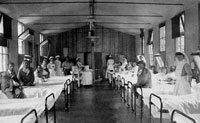
Casualties at Ampton Hall
|
|
blank |
Somehow the country had to deal with large numbers of war casualties. The regular hospitals were quickly overwhelmed and other places had to be pressed into service. In October 1914 Ampton Hall was taken over by the Red Cross for use as a Hospital for casualties until January 1919.
|
|

Livermere Forge
|
|
blank |
As well as soldiers, the war effort needed horses, the motive power of the day. Motor vehicles were in use, but the bulk movement of materials still needed horsepower. Thousands of farm horses were requisitioned by the army. At Great Livermere, as at many other forges, local army encampments needed the blacksmith's services to shoe the armies of horses needed. Samuel Gathercole was the Livermere blacksmith at this time. Many of these horses, like the men they supported, were killed in the conflict. The forge at Great Livermere is one of a small handful of forges which survive today on village greens.
|
|

Belgians at Plumpton House
|
|
blank |
The Bury Free Press of 26th December, 1914, reported on the hospitality extended by Walton Burrell senior to a large number of officers temporarily stationed in this district. "Since then, his elder son, Mr W R Burrell has been affording much pleasure to many officers and men located at Plumpton House, Whepstead, as also a number of Belgian refugees, by a display of his skill as an amateur photographer."
"Another (picture) shows a string of the large number of horses at present quartered on the land farmed by Mr Burrell. I believe the horses located there total about two hundred in all."
|
|
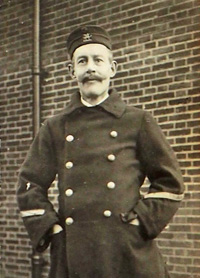
WRB as Belgian sergeant
|
|
blank |
Walton Burrell always seemed to quickly get on good terms with everybody he met. At Plumpton House at Whepstead he photographed himself wearing the coat of a Belgian army sergeant. Unusually for this family album now in the West Suffolk Record Office, there is a whole page, (p 75) devoted to one location and time, at Plumpton House. There are many other postcards in circulation of Burrell with other groups of soldiers where he includes himself wearing an borrowed army uniform. Watch out for his distinctive moustache.
|
|
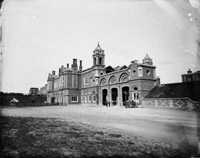
Northgate Railway Station by 1854 |
|
1915 |
In 1914, Germany had only ten Zeppelin Air ships, but both the German army and its navy had recognised its military potential and begun a building programme. Zeppelins had been seen over England during 1914, but these were reconnaisance missions, and no bombs were dropped.
|
|
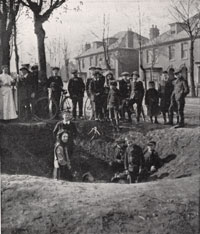
Northgate Avenue crater |
|
blank |
On that night of April 29th / 30th, 1915, when Linnarz's Zeppelin airship appeared over Bury, it was a bright moonlit night. The LZ 38 would now fly over the town and drop about 40 incendiary bombs and 4 high explosive bombs.
At Bury St Edmunds the full moon made good visibility and the airship first swung north of the town to attack Moreton Hall by about half past midnight. Flying over the Northgate Station, a bomb blew up a tree in Northgate Avenue near the East Anglian School. The picture here is from the Illustrated War News, of May 5th, 1915.
|
|
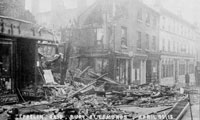
Destruction of Day's Shop |
|
blank |
In the town centre, the electric street lights were on, despite the Lighting Order, and house lights also came on as people woke up to see what all the noise was. Several incendiaries were dropped, one hitting number 8 Angel Hill. In the Buttermarket, Day's boot and shoe shop was set ablaze as were the adjacent shops, numbers 30 to 33.
|
|
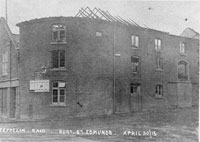
Kings Road Corner |
|
blank |
The attack moved to St Andrews Street, and Kings Road was hit. An Auction Room and warehouse at the corner of Kings Road and St Andrews Street, known as St Andrews Hall, was badly damaged. Next door were stables, also set on fire. Both premises belonged to James Pettitt, a motor engineer and corn merchant. The rebuilt premises are the home of Denny Brothers today.
Westley village was bombed at the end of the 20 minute attack. A large crater was left in a field which would later be used as a rubbish tip, and become filled in as part of the Westley airfield development in the 1930's. There were no deaths except for a dog and some hens.
|
|
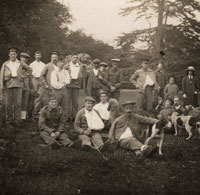
Casualties with otterhounds at Hengrave Hall
|
|
blank |
Similarly, Hengrave Hall became a hospital for the wounded. This postcard shows recuperating wounded soldiers at Hengrave Hall near Bury St Edmunds, which was used extensively in WW1. They are in the company of some people apparently named on the rear of the card, along with the words "Otter Hunt". I think they read as Mrs Cartmell, G Mizen, Mr Paley, Mrs Price and family. The reverse is also stamped Photo : W R Burrell, Fornham St Martin, Suffolk, negative 1101.
This card illustrates some of the difficulties of dating Mr Burrell's work. He has recorded the negative number as 1101, which would at first seem to be a date very early in 1914, long before there would have been recovering soldiers at Hengrave. However, the card is from May 1915.
|
|
 Ingham Camp
Ingham Camp
|
|
blank |
By the end of 1915 there were many army training and transit camps set up in the countryside of Britain. One such was The Camp at Ingham, set up to the southern end of the village. It housed at various times the 69th East Anglian Division of the Cyclist's Corps, the Royal Engineers and the Argyll and Sutherland Highlanders. It was served by the railway station at Ingham, on the Bury to Thetford line, and other notable army camps such as Barnham were along this line.
There are at least four views in existence of Ingham Camp. This one, with a negative number of 1386 might be from June or July, 1915.
The Breckland was ideal for training camps as the population was sparse, and there was little arable farming, as sheep grazing and pheasant shoots were all that the land could support. Places like Cavenham Heath became home to the East Anglian (Essex) Royal Garrison Artillery from 1914 until February 1916.
|
|

Essex heavy battery at Cavenham |
|
blank |
This superb photograph by Walton Burrell shows members of the heavy battery of the East Anglian (Essex) Royal Garrison Artillery drinking in their canteen at camp at Cavenham. The battery had been stationed at Cavenham from 1914 until their departure in February, 1916. This view was taken in December, 1915, and is labelled as negative number 2077.
|
|
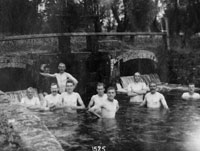
Soldiers at Duck Sluice 1915
|
|
blank |
Here we see soldiers bathing at Duck sluice, on the River Lark, at Fornham St Genevieve, Suffolk. The SRO reference is K997/67/12, ( Former reference: 1585) dated 13 August 1915. Duck sluice today is completely derelict and only a few bricks remain to show its location. Its original purpose was to control the water supply to an offshoot of the River Lark, which also no longer exists.
|
|
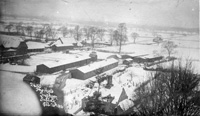
Ingham Camp February 1916
|
| 1916 |
This picture by Walton Burrell shows the date and the negative number on its face. Ingham Camp in the snow is negative 2450 and is dated 26th February 1916.
Until March 1916, the British army was made up of the regular soldiers and large numbers of volunteer battalions. Their losses were such that volunteers were no longer enough. In March 1916 all single men aged between 18 and 41 were liable for conscription. Walton Burrell was already aged 53 by this time so even without his disability he would not have been able to join up. So he did his bit by recording the men in the local army camps and visiting and assisting the wounded in the local military hospitals.
|
|
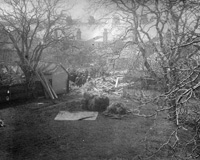 Springfield Road bomb damage
Springfield Road bomb damage
|
|
blank |
Aerial warfare returned to Bury St Edmunds when Zeppelin airship L16, commanded by Werner Peterson, appeared overhead just before midnight on Friday 31st March, 1916.At Bury St Edmunds, the street lights were quickly turned off this time, but the L16 bombing run began from the Northgate railway station towards the town. This time seven people were killed and several premises destroyed. Some deaths occurred in Raingate Street and Springfield Road, and there was a great deal of destruction, but accounts now published were deliberately vague as to locations.
|
|
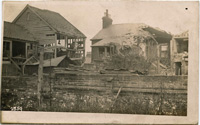 Mill Road bomb damage
Mill Road bomb damage
|
|
blank |
Mill Road and Chalk Road houses were hit, possibly in an attempt to attack the old barracks in Kings Road, or the engineering works of Robert Boby. This postcard with Burrell negative number 2559 was identified as bomb damage at Mill Road by a copy being included in the Burrell album, and labelled by Burrell himself.
|
|
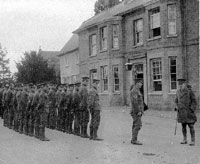 Sappers at Fornham St Martin
Sappers at Fornham St Martin
|
|
blank |
This picture is taken from a postcard published by W R Burrell of Fornham St Martin. It shows the Woolpack inn, which still exists, and soldiers of the Royal Engineers on parade. Burrell photographed other army camps around the area, including the Ingham pictures above,and the Ampton hospital picture.
|
|
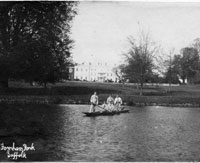
Punting on the lake
|
|
blank |
This picture shows five wounded soldiers enjoying a punt on the lake in Fornham Park, Suffolk. It bears the date 1st May 1916, and Fornham Hall is visible in background. They are clearly dressed in their hospital blues, which were thought to maintain discipline, while showing the world that they were wounded in action.
The ornamental garden in front of the House still seems to be visible.
|
|
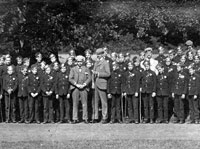
George Manners
|
|
blank |
George Manners with messenger boys from London, seen in Fornham Park, in August 1916. Suffolk Record Office Reference K997/101/5. George Manners was the owner of the Fornham Estate at this time, but it is not thought that he lived here very much, having other homes elsewhere. In 1920 he would become Sir George Manners. These boys were presumably on an outing from London, although they are in their messenger uniforms.
|
|
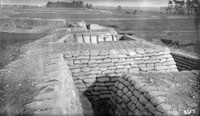
"German" trenches
|
|
blank |
By May, 1916 Colonel Swinton had set up a secret battle training area on Lord Iveagh's Elveden Estate to test out the results of the engineering prototypes. To maintain secrecy, the commissioning committee referred to these prototypes as tanks. Production models sent to Thetford were painted up with the words "Handle with Care - Petrograd", in cyrillic letters.
|
|

Mock No Man's Land
|
|
blank |
A restricted zone was set up which included North Stow, and trenches and obstructions dug to simulate No Man's Land and the trench systems in France. These trials were impressive enough that 49 tanks were shipped to France for their first active service on September 15th 1916 at the Somme.
Burrell's negative number 3621 shows part of the terrain before reinstatement.
The Suffolk Record Office has this picture labelled as "Quarry pit, West Stow, Suffolk....Showing tracks of tanks". It seems likely that this is, in fact, one of the craters deliberately produced by explosives to simulate the Western Front. It is more likely to be at North Stow than West Stow.
(Picture Source - Suffolk Record Office, Walton Burrell Archive)
High security prevailed until the last tank was dispatched to France in September, after which, a new tank facility was set up at Bovington on 27th October, 1916. Burrell's pictures were taken from September, 1916, and show the mock battlefields and the men and machines drafted in to reinstate Lord Iveagh's estate to its former appearance.
|
|
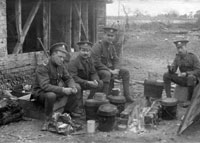 Tank training area North Stow
Tank training area North Stow
|
|
blank |
It is unclear exactly where these trials were carried out, but second hand eye witness accounts talk of extremely high security being installed around the tank testing perimeter. This extended from Elveden south to Icklingham, where troops were camped, and used for guard duties. At times of the highest security it is said that guards were placed as close as a few yards apart, all around the area.
|
|
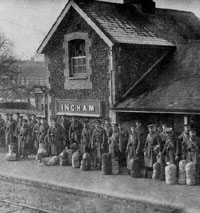 Troops at Ingham Station February 1917
Troops at Ingham Station February 1917
|
| 1917 |
This view of Ingham railway station by Walton Burrell shows Royal Defence soldiers leaving for Masham in Yorkshire, and is dated 11th February, 1917. These were the men who had spent some months in building, and then destroying, the mock battlefield at Elveden.
Other soldiers were continually arriving for training at Ingham Camp, and then travelling onwards to their next destination. Today this railway station site houses light industries. The railway station at Ingham was on the Bury to Thetford line, and other notable army camps such as Sandy Barracks and Barnham Camp were also along this line.
|
|
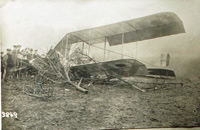
Crash at Ingham Feb 1917
|
|
blank |
This picture is labelled in Burrell's hand as "Aeroplane accident at Ingham Feb 1917". The aeroplane seems to have hit the branches of a tree and crashlanded. It carries the British roundel markings. Accidents with these early planes were fairly commonplace and were often fatal. There is no record of a fatal crash in this instance and Burrell does not mention any fatality. It carries negative number 3849.
|
|

Argylls at Flempton golf course 1917
|
|
blank |
In May 2020 I was pleased to receive an email from Mr Omar James-Johnson including this scan of a Walton Burrell postcard of Argyll and Sutherland Highlanders playing golf at Flempton Golf Course. The negative number of 4037 places it in 1917. On the reverse is the Burrell stamp W R BURRELL FORNHAM BSE and the hand written name of the recipient MRS ASHEN and her address.
Mr James-Johnson writes, "I thought you might like to add the attached photograph to the St Edmundsbury website.
I came across it researching the history of Flempton Golf Club of which the photographer Walton Burrell and his family were members. (Walton Burrell is in an old club members book from the early 1920s)
Apparently he produced a series of postcard photographs of and around the golf club which were sold in the clubhouse. I have yet to come across anymore, but thought that with Flemptons strong military membership at the time and WW1 it would fit nicely on the site.
It shows Argyll and Sutherlanders on the course and I have dated it to exactly 1917 using reference to Walton Burrells numbering."
|
|
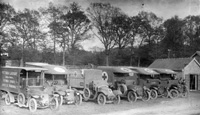
Ambulances at Ingham Station
|
|
blank |
This is a Walton Burrell photograph of ambulances waiting to transport wounded soldiers from the railway station at Ingham to Ampton Hall, which served as a Red Cross hospital during the First World War. It is dated 19th May 1917, and bears negative number 4159. Note the Victoria Laundry van lending help. All the drivers were volunteers, often with their own full time jobs as well.
There were 92 such convoys on this run from October 16th, 1914 to the hospital's closure in January, 1919.
Walton Burrell recorded that he visited Ampton Hall hospital for wounded soldiers 564 times throughout 1917. He took many pictures of them and the hospital wards that the men could send home, or keep for souvenirs. These were all routinely printed on postcard stock.
|
|
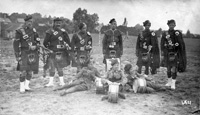
Lovat Scouts July 1917
|
|
blank |
This picture of Lovat Scouts pipes and drums is dated 29th July, 1917. It carries negative number 4521.
|
|
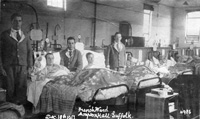
French Ward December 18th 1917
|
|
blank |
This is another usefully dated postcard complete with its negative number of 4986. It shows the interior of French Ward at Ampton Hall on 18th December, 1917.
|
|
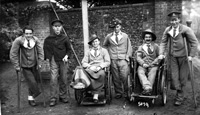
Australians at Ampton
|
| 1918 |
This picture carries negative number 5079, which should place it around January, 1918. It shows Australians at Ampton Hall hospital. Incredibly, Walton Burrell would find the time to visit the men in hospital at Ampton Hall some 623 times during 1918.
|
|

George Arthur Ward March 2nd 1918
|
|
blank |
George Arthur ward at Ampton Hall hospital was one of several named wards set up here. This picture is negative number 5158 and is dated to March 2nd, 1918. Another picture in this ward taken on the same day is negative number 5159.
|
|
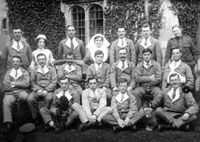
Hengrave Hall 1918
|
|
blank |
Hengrave Hall was yet another large building used for hospital purposes during the Great War. Walton Burrell took this picture on 22nd April, 1918. Members of the staff are shown with recovering soldiers. Note the two accompanying dogs, one representing a Scottish regiment.
|
|
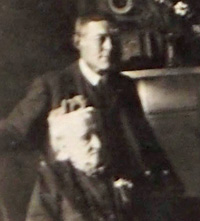
WRB and his mother April 1918
|
|
blank |
By April 24th 1918, Walton Burrell had shaved off his moustache, as seen in this indoor picture with his mother on that date. This changed his appearance somewhat. Perhaps at age 55 he wanted a more youthful look. The picture was part of the celebration of his parents' 56th wedding anniversary.
|
|
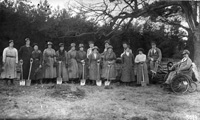
WLA at Ampton Estate
|
|
blank |
This picture from SRO by Walton Burrell shows members of the Women's Land Army working on the Ampton Estate in 1918, with 5 recovering wounded soldiers from the Ampton Hall hospital. The negative number is 5073.
|
|
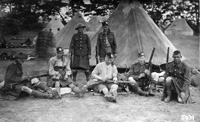
Gordon Highlanders at West Stow camp
|
|
blank |
Some of Walton Burrell's pictures survive with precise dating, while others do not. This one is labelled Date 23 May 1918. These Gordon Highlanders are at camp at West Stow, Suffolk. Seven soldiers are seen outside a tent at the army camp, while the 8th man has moved during the exposure and exists only as a blur. Others are visible in the background. It carries negative number 5431.
|
|
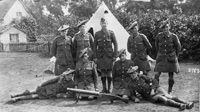
Gordon Highlanders at West Stow camp
|
|
blank |
This picture of Gordon Highlanders at West Stow camp is negative number 5783, and is dated to 7th August, 1918.
|
|
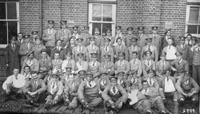
Canadians at Mill Road Hospital
|
|
blank |
Mill Road Hospital was part of the West Suffolk Hospital complex on Hospital Road, Bury St Edmunds. This negative is number 5999 dated to September, 1918.
|
|
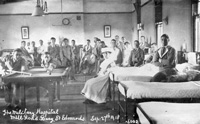
Ward at Mill Road Hospital
|
|
blank |
This picture has been dated on the negative and so we can be confident of the date of September 27th, 1918, negative number 6002. This picture gives us a good guide to dating the previous picture to the same day or just shortly before.
|
|
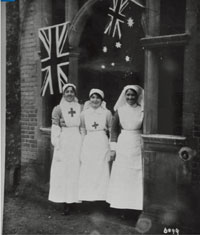
Ruby Ingram far right of picture
|
|
blank |
This picture, number 6099, is dated as November 11th 1918, which was celebrated as Armistice Day. This picture by Walton Burrell comes from this Australian website:-
https://anzacportal.dva.gov.au/resources/australian-women-and-war#2
Burrell's family album has three named pictures of Sister Ingram, but not this one.
Sister Ruby M Ingram was an Australian who served with the British Red Cross and the French Red Cross, which I believe was operated as part of the British Red Cross, writes one of her descendants, Monica Lockheed. Her medal index card shows that her British War and Victory Medals were issued for war service with the French Red Cross. The abbreviation is FRX. She received a Royal Red Cross 2nd Class in April 1919 at Buckingham Palace for her war service.
She's recorded in one Australian publication as being one of the nurses who served with the British. This is because she was not an Army nurse in the Australian Army Nursing Service, (AANS), and presumably didn't wish to be so. The vast majority of Australian nurses who served in World War I enlisted in the AANS. However, Ingram was already a Sister which means she ran a Ward, was already a higher rank than a nurse. Later becoming Assistant Matron, and then Acting Matron in 1919 at Ampton, explaining her decoration.
Her home was at Thalassa, 14/17 Byrne Avenue, Elwood, Victoria, Australia, a considerable mansion in its day.
More than 60,000 Australian soldiers died during the war, and at least twenty-five nurses, the latter serving in all theatres where the Australian Army was sent, including Gallipoli, Egypt, Palestine and France.
|
|
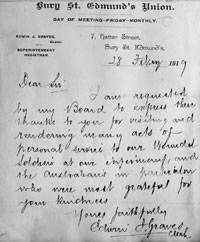
Letter to W R Burrell
|
| 1919 |
In January, 1919, the Red Cross hospital at Ampton Hall closed down. It was reckoned to have treated 6,568 sick or wounded soldiers since opening in October, 1914. Walton Burrell recorded that 92 convoys had been run from Ingham station to Ampton in order to bring in the wounded since October 16th 1914. These ambulances and other borrowed vehicles were all driven by volunteers.
Burrell himself had recorded that during 1917 he had visited Ampton hospital 564 times, during 1918 he made 623 visits, and even in its last month in 1919 he visited 42 times prior to its closure. It is clear from these figures that on most days he was there twice or more a day, perhaps taking orders for tobacco etc in the mornings and bringing flowers and making deliveries of purchases and developed photographs later in the day.
With the closure of local emergency wartime hospitals it was time for the authorities to take stock. Walton Robert Burrell had been a frequent visitor to comfort injured soldiers throughout the war. Born profoundly deaf, he was both too old and unfit for military service, but combined his occupation, photography, with his voluntary hospital visiting. Burrell produced many photographs as postcards for soldiers to send home to their loved ones, as part of his help and assistance. This letter of appreciation, dated 18th February, 1919, was sent from Edwin J Graves, Superintendent Registrar, Bury St Edmunds Union. It expresses thanks from the board for Burrell's visits and acts of service to the wounded soldiers at the infirmaries. Particular mention is made of his visits to Australian soldiers.
|
|
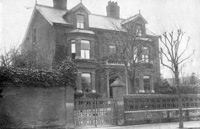
43 Risbygate Street
|
|
blank |
Walton Burrell had lived at Hall Farm, Fornham St Martin with his parents, Walton senior and Ellen, (nee Cowen) since he was born in 1863. In 1919 his father gave up the tenancy of the farm and moved to the substantial property at 43 Risbygate Street, Bury St Edmunds.
|
|
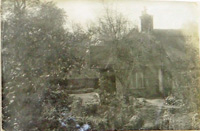
WRB's cottage at Ampton
|
|
blank |
With his parents giving up Hall Farm, Walton Robert Burrell moved to Ampton in 1919. This view shows his cottage at Ampton, which he photographed during an eclipse.
|
|
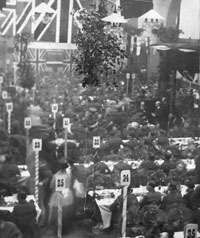
Banquet for POWs
|
|
blank |
In January and February some of the 1/5th Suffolks returned home from Egypt, but rioting in Cairo slowed up the demobilisation. Not until May did they all get away.
In January the Suffolk Regiment returned Prisoners of War were given a banquet by the grateful Mayor and Corporation of Bury St Edmunds. The feast took place in the Corn Exchange, and the room was decorated with flags and flowers. Crowds of people turned out to welcome the POWs to the event.
|
|
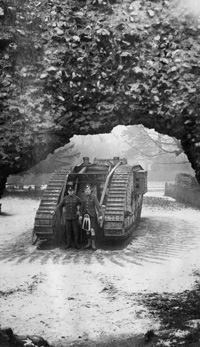
British tank on display
|
|
blank |
On July 19th 1919 Bury held its celebrations of the peace, and next day the great Peace Procession was held in central London.
The mood of euphoria continued when in December, 1919, Bury was presented with a defunct mark I British tank sporting the name "Kaffir" and the number 8093, (not a captured German Kiffir Tank, as has previously been reported), to reward the town's contribution of two million pounds raised by the local war savings committee for the war effort.
The concrete pad on which it stands in the Abbey Gardens may still be seen, and it looks as if this picture may have been taken shortly after the tank was installed as you can see the tracks in the snow where it turned round.
|
|
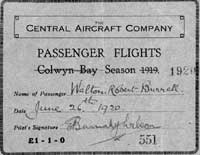
Ticket to ride, June 1920
|
| 1920 |
By 1920 the idea of air travel was still new and exciting. It was also easy for the aircraft of the day to take off and land using any flat grass field. Crowds could always be relied upon to turn up to any flying event of the time. On June 26th, 1920, this ticket to enjoy an aeroplane ride for one guinea was issued to Walton Burrell by the Central Aircraft Company. By the 1930s these trips and landing strips had to be properly authorised.
|
|
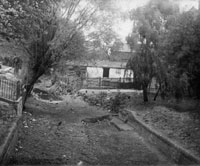
River Lark dry at Eastgate Bridge
|
|
1921
|
Droughts were not confined to the days of global warming at the end of the 20th century. The summer of 1921 was so dry that the River Lark dried up. This view shows the dry river bed seen from Eastgate Bridge looking north. It is notable how much silt had accumulated in the river bed at this date. Crop yields were drastically damaged by the drought, and although this should have led to a rise in farm prices, the government encouraged cheap imports of foreign food to compensate for the lack of supplies.
|
|
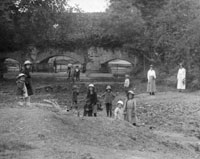
River Lark dry in the park
|
|
blank |
For years Bury residents have referred to the Abbey Gardens as "the Park". The description of this photograph, from the Suffolk Record Office, illustrates that this designation has a long history. The description states, "The river quite empty in the park by the Abbots bridge at Bury during the very long dry weather". In the Abbey Gardens, people could walk along the dry river bed.
|
|

Ampton memorial 1921
|
|
blank |
The year 1921 was when war memorials started to spring up all over Suffolk. Ampton was a village close to Burrell's heart not only because he was living there at the time, but because of his close connection to Ampton Hall military hospital during the Great War.
|
|

Red Cross hospital closed
|
| 1923 |
On January 2nd, 1923, the Red Cross Hospital in Northgate Street was closed down. This picture shows the hospital in 1917, negative number 4732, with its flag pole flying the Union Jack and Red Cross emblem.
|
|
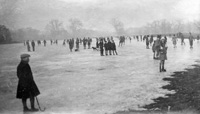
Skating at Livermere
|
| 1929 |
This picture from 1929 is not the last picture Walton Burrell ever produced. We know that he took many pictures on his trips abroad, including the major visit to Australia in 1931.
However, it is probably the most recent picture to survive in the family album at the Suffolk Record Office.
|
| 1930 |
In 1930 Walton Burrell moved from Ampton to The Ramblers, School Road, Gt Barton, where he remained for just three years until 1933. (BFP 8/10/1932) He was attracted to Great Barton because his brother Frank was also now living in that village.
|
| 1931 |
In 1931 Walton Burrell embarked upon his boldest foreign adventure at the age of 68 when he set sail for Australia on a P&O ship, "Bendigo". He returned on the steamship "Moldavia" on 5th November, 1931, following three months in the north of Queensland viewing the Great Barrier Reef and visiting the Aboriginal peoples there. He also spent two months with a cousin, Mrs W T Bennett of Kangaroo Point.
|
|
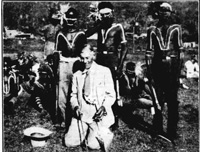
BFP article on WRB Oct 1932
|
| 1932 |
In October Walton Burrell was interviewed for a one page feature in the Free Press and Post newspaper, published on Saturday, 8th October, 1932. Many facets of his life are illuminated by this article. Although deaf he learned French, German, Italian and Spanish in order to travel overseas. We learn that he visited over 20 countries, including six visits to Egypt. His longest journey was made in 1931 when he visited Australia, not only to see relations, but he also met a number of ex-soldiers who he had previously met in Ampton military hospital.
The article can be read as a PDF file by clicking on the thumbnail of Walton Burrell among the aboriginal inhabitants of Palm Island, Australia.
|
|
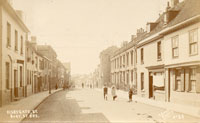
4 Risbygate Street second on the left
|
| 1933 |
In 1933 Walton Burrell moved to Miss Sexton’s at 4, Risbygate Street, possibly preferring in his 70s to be looked after in lodgings. He would live here until his death in 1944. This was at the "top" of the street, on the left hand side looking away from the town centre. In this picture by photographer H Cook, it is the second building on the left.
|
|

BFP funeral report
|
| 1944 |
On 24th November, 1944, Walton Burrell passed away, and he was buried at the church in his home village of Fornham St Martin, where he had lived until 1919. He was 81 years of age.
The Bury Free Press and Post for December 1st, 1944 contained a report of his funeral. This can be read by clicking on the thumbnail to see the entire article as a PDF file.
Probate was granted to Monica Frances Faith Boldero, spinster, at Ipswich in March, 1945. Monica was the daughter of Walton's oldest sister, Ellen Marion Burrell who had married the Reverend Henry Boldero. Walton Burrell's effects totalled £2978 8s 9d, a not inconsiderable sum.
|
|
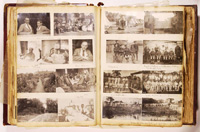
Burrell Family Album p32
|
| 2000 |
In March 2000 the Friends of the Suffolk Record Office purchased a volume of family photographs by Walton Burrell. This album contained about 2,000 of Walton Burrell's pictures, out of an estimated total of 20,000 taken over his lifetime. In addition we know from his 1932 interview that he had "several huge albums crammed with pictures", of which this was only one.
The album had taken a battering over the years, and at least 40 pages were thought to be missing. In addition the pages are not chronological, and pictures from different years appear to be randomly added to the same page.
For example the banquet for the Suffolk prisoners of war, at the Corn Exchange, Bury St Edmunds, in January 1919 appears on page 2 of the album, along with views from 1915 and of a golden wedding party in 1912.
Nevertheless this seems to be our only key to identifying Burrell's pictures, and in many cases our only hope of identifying the subjects and people depicted.
We live in hope that further albums will turn up in future.
|
|
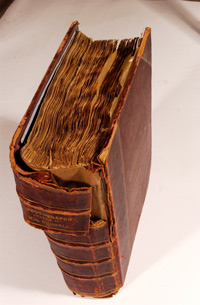
Burrell Album as purchased
|
| 2004 |
In 2004 and 2005 a few of Burrell's photographs in his album were digitised by Suffolk Record Office and subsequently published on the internet for a limited period.
The Suffolk Record Office described it thus:-
"In 2004 the binding was recorded and disbound so that most of the photographs could be digitised; the sections were then stored unbound. During disbinding it became clear that the album was an amalgamation of at least two previously separate albums. The extent of damage to the album also became clear including that pages and photographs were damaged or missing and even one or two whole gatherings lost."
The original binding must have been professionally done, as shown by the picture here, and the gold leaf lettering on the spine, saying, "Photographs taken by W R Burrell."
|
|
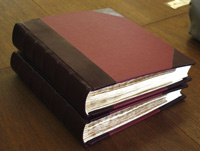
Burrell Album repaired and rebound
|
| 2008 |
Work to restore the album began in 2008, and according to the Record Office:-
"In 2008 work began to give the pages a permanent housing but first we started by conserving the pages and photographs themselves. The edges of most pages had multiple tiny tears through handling; these were repaired with very thin Japanese tissue and any missing parts replaced with Japanese paper dyed to blend in. The tissue was pre-coated with adhesive to minimise the amount of moisture needed to adhere it which reduced the risk of bleeding of the moisture-sensitive ink, often present in captions near the page edges. Missing areas or whole pages were replaced with blank paper that generally matched the originals in colour and weight.
Some photographs were dog-eared or creased causing cracking to the emulsion; these were repaired with a tissue lining on the reverse and re-adhering the emulsion on the front. One of the most troublesome tasks of this stage was the removal of a modern adhesive that had been used to repair a break at the spine; we used solvent vapour to soften and remove it.
After the photographs had been scanned we decided to rebind them in a facsimile of the original binding to preserve the look and feel of an album but this time it would be split over two volumes."
|
| 2014 |
In 2014 the BBC produced a series of video items entitled, "World War 1 at Home". Suffolk Record Office contributed a 3 minute piece on Walton Burrell's Great War photographs called, "Bury St Edmunds, Suffolk: Capturing the War -
Walton Burrell: the Suffolk man who spent the war years photographing life at home."
This was first published on 28th May, 2014, and may still be viewed online here:
Walton Burrell: Suffolk Photographer
|
|
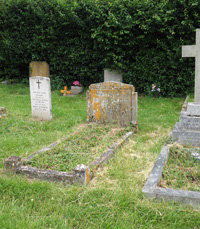
Burrell's grave seen in 2019
|
| 2019 |
During 2019 these memorials of Walton Burrell were first presented to the Bury St Edmunds Postcard Club in a PowerPoint presentation by the author. Walton Burrell's grave is shown here seen on July 1st 2019. I had previously tried to locate it by eye, but the inscription is now very unclear due to time and lichen etc.. The church burial records tells us to look for grave 451, which is just inside the rear extension to the churchyard, almost opposite the access gateway. It records his dates of birth and death, but the one line inscription below the normal details is unfortunately unreadable today.
| 2023 |
In December, 2023, Hannah Salisbury of the Suffolk Archives, gave a talk at the Record Office in Raingate Street on Walton Burrell and the Deaf Community. Several projects had been run with schools in the town to explore the world of the deaf and to inspire the hard of hearing with the achievements of Walton Burrell, who now appears to be the earliest known deaf photographer.
| |
Originally prepared for the St Edmundsbury History website
by David Addy, June 15th 2019
RESOURCES USED
Author's collection of postcards
Postcard pictures supplied by Gerald Brown
Postcard pictures supplied by Martyn Taylor
Suffolk Record Office, Bury St Edmunds - Walton Burrell Family Album in two volumes. This is helpful to establish that some unattributed pictures were actually taken by Walton Burrell. Also in some cases, but far from all, pictures are dated by him.
Australian website https://anzacportal.dva.gov.au/resources/australian-women-and-war#2
|



















































































